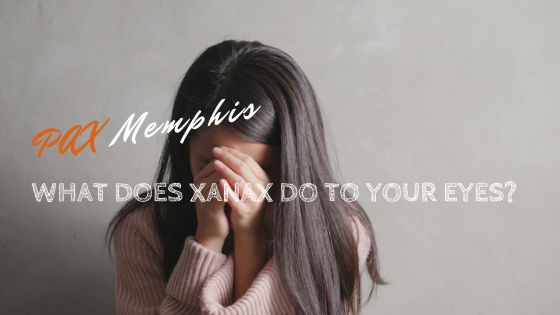Xanax is the brand name for a benzodiazepine medication called alprazolam. As a central nervous system depressant, Xanax decreases activity in your brain. People might experience symptoms like drowsiness, dizziness, and sedation when they consume Xanax.
Doctors prescribe Xanax to treat anxiety and panic disorders. While Xanax can offer a sense of calm for people with anxiety, it is addictive. As a result, doctors do not prescribe it for long-term use.
According to a study published in the National Library of Medicine (NLM), 17.2% of people in the United States who use benzodiazepines like Xanax are abusing it.
If you are addicted to Xanax, there are several adverse reactions to watch out for. Examples of long-term effects of Xanax abuse include overdoses, changes in behavior, and even a negative impact on your eyes. While the effects of Xanax on your eyes are less discussed, they are important to be aware of.
Some people might use the term “Xanax eyes” to describe the negative side effects the substance causes. People might have dilated pupils, blurred vision, light sensitivity, and increased ocular pressure. If individuals leave the effects of Xanax on their eyes untreated, it can lead to serious consequences, including blindness.
What are the Effects of Xanax?
Xanax works by increasing the effects of gamma-aminobutyric acid (GABA) in the brain, causing people to feel relaxed and calm. This is why the medication is commonly prescribed to treat anxiety conditions and panic attacks. However, this calm feeling can become addictive for some, increasing the chances they will begin abusing Xanax.
The common side effects of Xanax include:
- Relaxation and calmness
- Dizziness and drowsiness
- A rush of euphoria
- Lightheadedness
- Tiredness and sedation
- Chattiness
- Trouble concentrating
- Irritability
- Dry mouth or increased salivation
- Nausea
- Constipation
- Changes in appetite and weight
- Trouble urinating
- Joint pain
Side effects may occur when an individual first starts taking Xanax. Typically, they subside once a person’s body adjusts to the medication. However, side effects will become increased if someone begins engaging in substance abuse.
If a person begins abusing Xanax, they should look out for the signs of Xanax addiction. Common signs include using more than one intended or experiencing cravings to consume Xanax. If an individual experiences the symptoms of Xanax addiction, they should seek professional addiction treatment as soon as possible.
What Happens to Your Eyes on Xanax?
The most obvious effect that Xanax has on an individual’s eyes is pupil dilation. To explain, Xanax causes an increase in the availability of GABA in a person’s brain. This chemical is responsible for relaxing muscles.
Since Xanax leads to muscle relaxation, a person’s eyes might begin to dilate. This makes it easy for the loved ones of addicts to tell if their family member has recently abused Xanax.
People might also develop bloodshot eyes when they are under the influence of Xanax. This is largely due to the substance drying out the eyes, causing them to appear red.
Can Xanax Affect Eyesight?
Not only can Xanax lead to dilated pupils and bloodshot eyes, but it can also lead to impacted eyesight. Understanding how Xanax affects eyesight can deter people from abusing it regularly.
The ways Xanax can affect a person’s eyesight include:
Blurry Vision
Xanax leads to the relaxation of one’s entire body. When someone is abusing Xanax, that relaxation can extend to the eyes. As a result, someone abusing Xanax might experience blurry vision while they are under the influence.
Lazy Eye
People who have been abusing Xanax long-term have reported developing amblyopia (lazy eye). “Lazy eye” is characterized by a loss of control in the muscles of the eye. Since Xanax relaxes a person’s muscles, it’s easy to see how severe cases of substance abuse can lead to this condition.
Dry Eyes
Abusing Xanax can lead to dry eyes. Unfortunately, having chronically dry eyes can lead to long-term effects, including discomfort, itchiness, and even blindness (in severe cases). While it is possible to temporarily treat dry eyes with eye drops, the only way to resolve it is to quit abusing benzodiazepines.
Light Sensitivity
Xanax enlarges a person’s pupil while they are under the influence. When someone has dilated pupils, they are extremely sensitive to light.
Increased Symptoms of Glaucoma
While uncommon, Xanax can increase eye pressure. For this reason, many doctors are hesitant to prescribe Xanax to people with conditions like glaucoma. If someone who has glaucoma abuses Xanax, their symptoms might become more severe.
Find Help for Xanax Abuse and Addiction
If you or a loved one suffers from Xanax addiction, it’s time to seek help. Long-term abuse of Xanax can lead to adverse effects on the eyes, life-threatening overdoses, and even organ damage.
Thankfully, drug rehab programs can help you overcome Xanax addiction. With a combination of medical detox, evidence-based therapies, and supportive care, you can recover from the disease of addiction.
At PAX Memphis, we understand how important it is to find a rehab center that works for you. That is why we ensure each of our clients is matched with an addiction treatment program that suits their needs.
Contact us today to get connected with a reputable Xanax addiction treatment center.
Medically Reviewed: September 25, 2019

All of the information on this page has been reviewed and verified by a certified addiction professional.










